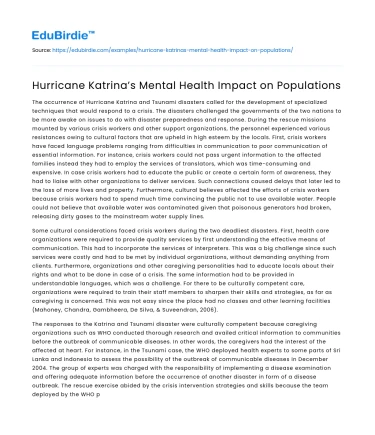The occurrence of Hurricane Katrina and Tsunami disasters called for the development of specialized techniques that would respond to a crisis. The disasters challenged the governments of the two nations to be more awake on issues to do with disaster preparedness and response. During the rescue missions mounted by various crisis workers and other support organizations, the personnel experienced various resistances owing to cultural factors that are upheld in high esteem by the locals. First, crisis workers have faced language problems ranging from difficulties in communication to poor communication of essential information. For instance, crisis workers could not pass urgent information to the affected families instead they had to employ the services of translators, which was time-consuming and expensive. In case crisis workers had to educate the public or create a certain form of awareness, they had to liaise with other organizations to deliver services. Such connections caused delays that later led to the loss of more lives and property. Furthermore, cultural believes affected the efforts of crisis workers because crisis workers had to spend much time convincing the public not to use available water. People could not believe that available water was contaminated given that poisonous generators had broken, releasing dirty gases to the mainstream water supply lines.
Some cultural considerations faced crisis workers during the two deadliest disasters. First, health care organizations were required to provide quality services by first understanding the effective means of communication. This had to incorporate the services of interpreters. This was a big challenge since such services were costly and had to be met by individual organizations, without demanding anything from clients. Furthermore, organizations and other caregiving personalities had to educate locals about their rights and what to be done in case of a crisis. The same information had to be provided in understandable languages, which was a challenge. For there to be culturally competent care, organizations were required to train their staff members to sharpen their skills and strategies, as far as caregiving is concerned. This was not easy since the place had no classes and other learning facilities (Mahoney, Chandra, Gambheera, De Silva, & Suveendran, 2006).
Save your time!
We can take care of your essay
- Proper editing and formatting
- Free revision, title page, and bibliography
- Flexible prices and money-back guarantee
The responses to the Katrina and Tsunami disaster were culturally competent because caregiving organizations such as WHO conducted thorough research and availed critical information to communities before the outbreak of communicable diseases. In other words, the caregivers had the interest of the affected at heart. For instance, in the Tsunami case, the WHO deployed health experts to some parts of Sri Lanka and Indonesia to assess the possibility of the outbreak of communicable diseases in December 2004. The group of experts was charged with the responsibility of implementing a disease examination and offering adequate information before the occurrence of another disaster in form of a disease outbreak. The rescue exercise abided by the crisis intervention strategies and skills because the team deployed by the WHO participated in offering support and assistance to communities. In the Aceh region, crisis workers participated in supplying laboratory goods, advising the locals on what to do, and helping the disabled to move out of trouble areas (Mills, Edmondson, & Park, 2007). In most societies, survivors of a crisis and their health conditions are usually used in evaluating the damages and responses to the crises. In the two disasters, the crisis workers did their best because they managed to salvage many victims. This shows that they must have used proper techniques and skills.
Did you like this example?
Make sure you submit a unique essay
Our writers will provide you with an essay sample written from scratch: any topic, any deadline, any instructions.
Cite this paper
-
APA
-
MLA
-
Harvard
-
Vancouver
Hurricane Katrina’s Mental Health Impact on Populations.
(2022, September 15). Edubirdie. Retrieved December 24, 2024, from https://edubirdie.com/examples/hurricane-katrinas-mental-health-impact-on-populations/
“Hurricane Katrina’s Mental Health Impact on Populations.” Edubirdie, 15 Sept. 2022, edubirdie.com/examples/hurricane-katrinas-mental-health-impact-on-populations/
Hurricane Katrina’s Mental Health Impact on Populations. [online].
Available at: <https://edubirdie.com/examples/hurricane-katrinas-mental-health-impact-on-populations/> [Accessed 24 Dec. 2024].
Hurricane Katrina’s Mental Health Impact on Populations [Internet]. Edubirdie.
2022 Sept 15 [cited 2024 Dec 24].
Available from: https://edubirdie.com/examples/hurricane-katrinas-mental-health-impact-on-populations/
copy






 Stuck on your essay?
Stuck on your essay?

